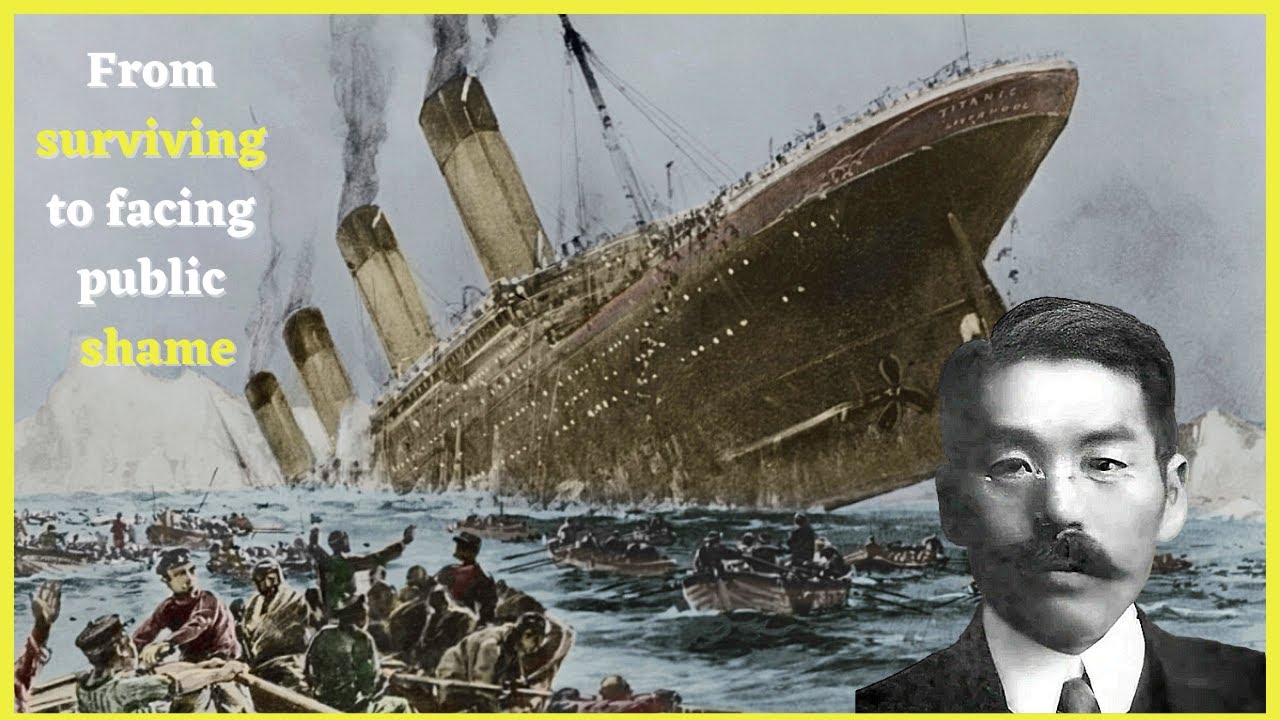He survived the Titanic… but paid a devastating price.
The world branded him a coward, shunned him, and even cost him his job. Who was the lone survivor of the Titanic whose story of survival became a lifelong curse? The truth behind his heartbreaking tale will shock you. Click to uncover the hidden side of this tragic figure.
👉 Read more here

The sinking of the RMS Titanic on April 15, 1912, remains one of history’s most haunting tragedies, claiming 1,496 lives and leaving only 727 survivors. Among them was Masabumi Hosono, the only Japanese passenger aboard the ill-fated ship. A civil servant with a promising career, Hosono’s survival should have been a tale of resilience. Instead, it became a lifelong burden, as he was labeled a coward, ostracized by his community, and even lost his job. This article delves into the heartbreaking story of Hosono, the cultural forces that shaped his condemnation, and the eventual reevaluation of his legacy, offering a poignant reflection on survival, shame, and redemption.
The Night of the Titanic’s Sinking
Masabumi Hosono, born on October 15, 1870, in Hokura, Japan, was a 41-year-old employee of the Japanese Ministry of Transport. In 1910, he was sent to Russia to study its railway system, a prestigious assignment that took him across Europe. On his return journey, he boarded the Titanic in Southampton as a second-class passenger, eager to return to his wife and children in Tokyo. On the night of April 14, 1912, as the ship struck an iceberg, Hosono was asleep in his cabin. Awakened by a steward, he faced chaos as he tried to reach the boat deck.
Barriers and crew assumptions initially blocked Hosono’s path, mistaking him for a third-class passenger due to his ethnicity. Despite this, he reached the deck, where he witnessed the desperate scene of lifeboats being launched and distress flares lighting up the sky. In a letter to his wife, later published, Hosono described the “hideous blue flashes and noises” of the flares and his growing sense of dread. As lifeboat 10 prepared to launch, an officer called out, “Room for two more!” Seeing another man jump aboard, Hosono followed, securing a spot on the boat. This decision, made in a moment of instinct, would haunt him for decades.
Rescued by the RMS Carpathia, Hosono wrote a detailed account of his experience on Titanic stationery, the only known document of its kind. He described the cries of the drowning and his own despair, noting how he initially resigned himself to sharing the ship’s fate. Yet, his survival marked the beginning of a different kind of tragedy—one of public shaming and personal torment.
The Backlash in Japan
Upon returning to Japan, Hosono faced a storm of criticism. The Japanese press and public condemned him for surviving when so many others, including women and children, perished. At the time, Japan was undergoing rapid Westernization, adopting values like the “women and children first” protocol popularized by Samuel Smiles’ 1859 book Self Help, which had become influential in Japan. Hosono’s survival was seen as a betrayal of these adopted ideals, particularly the expectation of self-sacrifice akin to the samurai code, though this was more a Westernized perception than a traditional Japanese value.
Newspapers branded Hosono a coward, with some alleging he disguised himself as a woman to secure a lifeboat spot—an accusation also leveled at other male survivors like J. Bruce Ismay but unsupported by evidence. Hosono was dismissed from his job at the Ministry of Transport, though he was later rehired on a contract basis due to his expertise. Public scorn extended to his family, with letters to newspapers demanding he commit suicide to restore honor. A 1997 article claimed that Japanese textbooks labeled him an example of dishonor, though a 2007 investigation by Andō Kenji found no such evidence, suggesting this was sensationalized.
Historian Margaret D. Mehl argues that Hosono’s ostracism stemmed from Japan’s embarrassment on the global stage, as the nation sought to align with Western values. His survival was perceived as a national disgrace, amplifying the stigma. Hosono himself remained silent about the Titanic for the rest of his life, reportedly tormented by guilt and shame. His family, too, carried the burden, with his grandson, Haruomi Hosono, a renowned musician, expressing relief when the family released Hosono’s letter in the 1990s, hoping to reshape his legacy.
The Cultural Context of Condemnation
The harsh judgment of Hosono reflects the cultural dynamics of early 20th-century Japan and the broader Titanic survivor narrative. In Japan, the Meiji era (1868–1912) saw a push to adopt Western ideals, including chivalric notions of male sacrifice. The “women and children first” protocol, while not universal, was a hallmark of the Titanic’s evacuation, with 74% of women and 52% of children surviving compared to only 20% of men. Male survivors, particularly those in first or second class, faced scrutiny in both Western and Japanese contexts, as survival was often equated with abandoning duty.
Hosono’s case was exacerbated by his status as the sole Japanese passenger, making him a focal point for national pride and shame. Unlike J. Bruce Ismay, the White Star Line chairman who also faced accusations of cowardice, Hosono lacked the social capital to deflect criticism. Ismay, though vilified, retained influence and contributed to maritime reforms, while Hosono’s quieter life left him vulnerable to public scorn. The false claim that he disguised himself as a woman, reported by American survivor Archibald Gracie and crew member Edward Buley, further fueled the narrative, though later investigations debunked this.
Reevaluating Hosono’s Legacy
Decades after Hosono’s death in 1939, his story began to be reevaluated. In the 1990s, following the release of James Cameron’s Titanic, the Hosono family shared his letter, offering a firsthand account of his experience. The document humanized him, revealing a man caught in a moment of survival instinct, not cowardice. A 1960 Japanese newspaper article defended him, framing his survival as luck rather than dishonor, and by the 2000s, historians like Andō Kenji argued that Hosono’s treatment was no different from that of other male survivors, exaggerated by media sensationalism.
The 2021 documentary The Six, which explored the forgotten stories of Chinese Titanic survivors, drew parallels with Hosono, highlighting how cultural biases shaped perceptions of survival. These survivors, like Hosono, faced discrimination and accusations of cowardice, often tied to their ethnicity. The reevaluation reflects a broader shift in understanding the Titanic’s legacy, recognizing the chaos of the evacuation—where lifeboat capacities were often underutilized—and the unfairness of judging split-second decisions in a crisis.
The Broader Implications
Hosono’s story raises profound questions about survival, shame, and societal expectations. The Titanic’s sinking exposed flaws in maritime safety, leading to reforms like the International Ice Patrol and mandatory lifeboat provisions. Yet, it also revealed the human cost of rigid cultural norms. Hosono’s condemnation reflects the pressure on individuals to conform to ideals of heroism, particularly in times of crisis. His experience parallels modern discussions about survivor guilt and the stigma faced by those who escape tragedy.
The new footage of the Titanic wreck, released in 2025, adds another layer to Hosono’s story. Images of preserved artifacts—a teacup, a suitcase, a child’s doll—remind us of the personal losses behind the statistics. Hosono’s letter, written on Titanic stationery, is a rare artifact itself, capturing the raw emotion of survival. As the wreck deteriorates, with experts predicting its collapse within decades, these stories become even more vital to preserving the human dimension of the tragedy.
Conclusion
Masabumi Hosono’s survival of the Titanic should have been a triumph, but it became a tragedy of its own. Branded a coward, he faced relentless public scorn, lost his job, and lived with guilt until his death in 1939. His story, once a symbol of shame, is now being reevaluated as a testament to the complexities of survival and the harshness of societal judgment. The Titanic remains a powerful metaphor for human ambition and vulnerability, and Hosono’s experience underscores the personal toll of its legacy. As we reflect on the haunting images of the wreck in 2025, we are reminded that behind every artifact lies a story—of loss, resilience, and, in Hosono’s case, a quiet struggle for redemption.





